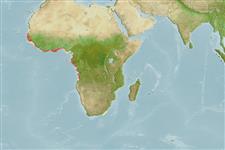>
Gobiiformes (Gobies) >
Gobiidae (Gobies) > Gobiinae
Etymology: Thorogobius: Greek, thoros = semen + Latin, gobius = gudgeon (Ref. 45335); laureatus: Name from Latin 'laureatus' meaning crowned with a laurel; referring to the shape of the scaled areas in the predorsal region..
Environment: milieu / climate zone / depth range / distribution range
Écologie
marin; profondeur 57 - 109 m (Ref. 118185). Tropical
Distribution
Pays | Zones FAO | Écosystèmes | Occurrences | Point map | Introductions | Faunafri
Eastern Atlantic: Angola and São Tomé and Príncipe.
Taille / Poids / Âge
Maturity: Lm ? range ? - ? cm
Max length : 7.4 cm SL mâle / non sexé; (Ref. 118185); 8.0 cm SL (female)
Description synthétique
Clés d'identification | Morphologie | Morphométrie
Épines dorsales (Total) : 7; Rayons mous dorsaux (Total) : 11; Épines anales: 1; Rayons mous anaux: 10; Vertèbres: 28. This species is distinguished from its congeners in the combination of following characters: D1 VI (second and third distinctly elongated); pectoral fin rays 19-22; short pelvic disc complete with well-developed anterior membrane (frenum), pointed lateral lobes; scales on nape and predorsal area in lateral band; opercle no scales; scales in longitudinal series 24-27; supratemporal rows tr and trp developed and extending transversally between pores H and K; longitudinal row g is long, passing row m posteriorly and relatively close to row h; infraorbital row 6 is long, ventrally extending to lower margin of preopercle, its ventral (6i) and dorsal (6s) originating opposite to each other; posterior lateral row h is long, reaching anteriorly above middle of opercle; body depth 18.9-23.8% at anal-fin origin in SL, head width 48.5-56.0% in HL; long upper jaw 41.8-58.0% in HL; minimum height of caudal peduncle 45.1-59.8% in caudal peduncle length; large eyes 23.9-30.9% in HL); long caudal fin 27.9-35.5% in SL; body pale fawn and brownish with margin of scale pockets dark brown pigmented, yielding a reticulated pattern; 5 brown blotches on flanks in lateral midline from below first dorsal fin to caudal peduncle; caudal fin with 6-7 distinct dark vertical bands (Ref. 118185).
Specimens were dredged on the upper slope of the continental shelf from soft bottom (Ref. 118185).
Life cycle and mating behavior
Maturities | Reproduction | Spawnings | Egg(s) | Fecundities | Larves
Sauberer, M., T. Iwamoto and H. Ahnelt, 2018. Two new deep-water species of the genus Thorogobius (Teleostei: Gobiidae) from the upper continental slope of the Eastern Central Atlantic. Zootaxa 4429(2):357-371. (Ref. 118185)
Statut dans la liste rouge de l'IUCN (Ref. 130435)
Menace pour l'homme
Harmless
Utilisations par l'homme
Outils
Articles particuliers
Télécharger en XML
Sources Internet
Estimates based on models
Phylogenetic diversity index (Ref.
82804): PD
50 = 0.5156 [Uniqueness, from 0.5 = low to 2.0 = high].
Bayesian length-weight: a=0.00708 (0.00333 - 0.01504), b=3.09 (2.92 - 3.26), in cm total length, based on LWR estimates for this (Sub)family-body shape (Ref.
93245).
Niveau trophique (Ref.
69278): 3.3 ±0.4 se; based on size and trophs of closest relatives
Résilience (Ref.
120179): Haut, temps minimum de doublement de population inférieur à 15 mois (Preliminary K or Fecundity.).
Fishing Vulnerability (Ref.
59153): Low vulnerability (10 of 100).
